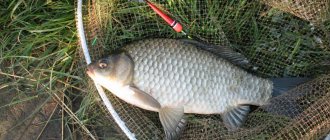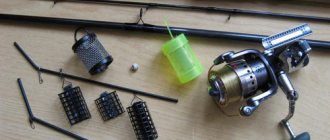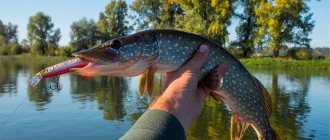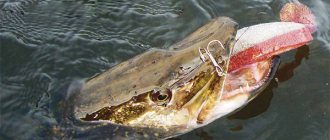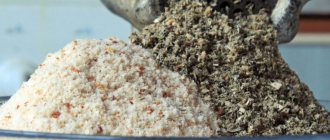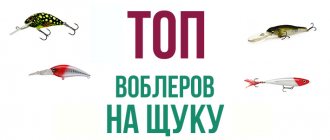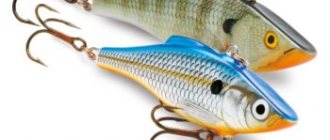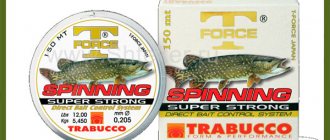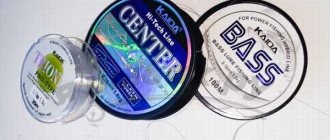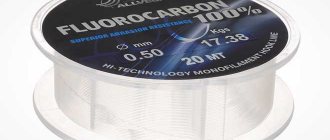Pike, like any predatory fish, is often inactive. And catching passive fish is a very difficult task. A diverting leash comes to the rescue due to its behavior in the water the bait passes through the water column most naturally and the fish are more willing to attack it.
Thanks to such equipment, you can successfully catch passive pike, including active pike, when other fishermen on the shore are left without a catch, fishing with wobblers, spinners or a simple jig.
Advantages and disadvantages
The advantages of catching pike on a retractable leash include the following:
- often works for passive pike, which does not go with conventional tackle;
- with such equipment you can make a good long cast from the shore, without using a boat;
- You can make targeted casts in almost all places of interest to the fisherman. This allows you to examine (for the presence of a predator) the largest area of the bottom;
- no windage, allows you to fish in any weather and any wind;
- good sensitivity at the time of wiring;
- artificial bait in the water looks more natural and natural.
The disadvantages of catching pike on a retractable leash include the following:
- takes some time to assemble and install;
- It’s difficult to do the installation for the first time;
- wiring is carried out at low speed. Not advisable when there are active predators;
- it takes some time to master all the skills of guiding in still water, as well as currents;
- negative when fishing in overgrown, rocky and clogged reservoirs, false bite signals occur;
- Cannot be used in swampy bodies of water. The sinker is sucked into the mud;
- Depending on the reservoir, it is necessary to carry out the installation accurately (correct dimensions), as well as select the bait.
Braided leash
fishx 04/24/2017, 10:42 4.1 thousand
Each fisherman has his own secrets and best practices. Here I am, no exception. As they say, the main gear that I fish with is a spinning rod, a float rod, an elastic rod (a donka with a rubber shock absorber) or a regular donka. And even among these gears, spinning takes up almost 80-90% of the time when fishing. And if you remember, when I said that it is not at all necessary to have an expensive spinning rod and reel, expensive baits and other components in order to stay with the catch. And taking into account the fact that I mainly fish on small rivers, even the cheapest spinning rod is capable of good casting. Of course, there are some incidents with the coil, but the latest purchase for 500 rubles so far works without any complaints. Well, continuing the conversation, I want to say that if you can “turn a blind eye” to some elements of the equipment, when fishing with a spinning rod, you need to pay close attention to the fishing line (braid).
I think the line should be good. This is a very broad concept, but in general terms, it includes such parameters as: strength, elasticity, resistance to tearing, uniformity of diameter along the entire length, the ability to maintain strength at knots, and, of course, lack of memory. It is clear that high-quality fishing line cannot have a low price tag, but depending on your capabilities and the task at hand, you can always find a worthy specimen in the group.
About 5 years ago I slowly switched to fishing with braided line. There are a lot of reasons for this, I’ll name just a few: high strength with a smaller diameter (compared to fishing line), does not stretch, i.e. it’s easier to feel the bite from a distance, in the current, in the wind, when jigging you literally feel the bottom. Braid has a lot of advantages, although it is not without some nuances of use, in particular subtleties of care so that the thread does not deteriorate (read about comparing fishing line with braid here, it may help). So, a good braid, as a rule, has a very impressive price tag. And I remember one season, I think it was a year or two ago, when over the summer I tore off 30-40 meters of good braiding. When a snag occurs, the fisherman initially makes every effort to free the tackle, but often the tackle breaks. And it’s okay if the break occurs literally at the bait, but meters of braid can remain in the water. I feel sorry for the good cord. This is precisely the reason why I resorted to some tricks. So, when I fish in difficult places, I tie the bait itself not to braid, but to a short leash made of fishing line (most often, 0.3 mm in diameter). The length of such a leash is only about 50-60 centimeters, and I do not attach it directly to the braided line (in this case, the braided line will simply cut the line under load), using a swivel. If desired, you can also attach a metal leash to a fishing line leash if you are fishing for large pike. And even if the tackle gets stuck somewhere deeply, and there is no way to unhook it, it doesn’t matter - when under load, the fishing line always breaks first, keeping the precious braid intact.
By the way, such a short piece of fishing line as a leader material does not affect the sensitivity of the tackle at all, but allows you to avoid loss of braid when hooked. I hope you'll take note.
Good luck to you and all the best.
Selection of fishing line, reel and spinning rod
If you are a novice fisherman, then for catching pike on a retractable leash, a regular inexpensive spinning rod from such manufacturers as Akara, Mikado, Shimano, Catana will suit you. The length must be chosen from 2.40 to 3 meters. This is the most universal length that will promote good casting and also help you catch trophies without loss.
The most common and universal spinning test is 5-25 grams, or 10-30 grams. Thanks to this test, you can cover all the necessary weights for pike lures.
The reel should be a spinning reel with a spool size of 2000 to 3000. It should lay well. It is best to take a reel with a front drag. This will contribute to good operational management and catching of the toothy fish.
You need to take a cord with a diameter of 0.16-0.20 mm. You can also take the simplest and most inexpensive braid, monofilament, as well as regular fishing line with a diameter of 0.25 to 0.4 mm. The main thing is that it flies off the spool well when casting and then fits evenly and compactly onto it. It is advisable to use a fishing line with low stretch , it can be of bright colors, which will allow you to control the bait well.

Why do you need a leash when fishing for pike?
The leash is a cord with loops at both ends, firmly connected to the main body of the leash by means of a crimp tube. At one end, as a rule, a carabiner is attached, at the other - a swivel for free rotation of the bait.
Used when fishing for pike to avoid biting the main line.
Do you need a leash when fishing for pike?
If, when fishing for pike perch or asp, fishermen’s opinions about the need for a leash differ, then when fishing for pike, anglers are unanimous. Fishing for “toothy” without a leash will be akin to a lottery: if you’re lucky or unlucky. In addition, if we take into account that pike baits are not cheap, then such a lottery will not be justified.
Even if a spotted predator is not the object of your hunt and you are hoping to fish for perch or catch pike perch, it is better to play it safe and take a couple of leashes with you. Pike is an omnivorous predator and may well covet perch or any other bait.
So, if your financial situation does not allow you to lose 8-10 expensive wobblers on each fishing trip, then you simply need a leash.
Is a pike afraid of a leash?
It is difficult to argue with the fact that the strongest leashes, capable of withstanding the teeth of large individuals, are clearly visible even in muddy water. But pike fishing is usually fast and aggressive, and the baits are often quite massive. So with a lightning strike, the fish is on the tee before it has time to see the piece of wire.
If you still have doubts, try more transparent and inconspicuous options for fishing, such as a fluorocarbon leash. Be prepared for the fact that its durability is lower than others.
Installation methods and equipment for spinning rods
In order to install a diverter leash for pike fishing with your own hands, you need the following:
- sinker, it can be elongated in the shape of an olive or in the shape of a small, thin pencil, it is also called a Tyrolean stick;
- offset hook;
- swivel or better yet a tee with swivels;
- fishing line for the diverter leash itself; In principle, any diameter of at least 0.20 mm is suitable for equipping leashes;
- cord or main line that is wound on the spinning reel;
- bait, maybe anything.
A triple swivel is attached to the main cord. For the top ring using a clinch knot (but you can use any other one). If fishing line is used, it must be wetted so that it does not burn when the knot is tightened. Of course, it will hold the knot, but when hooking or playing fish, this place will be weakened.
We proceed to the production of a leash from the swivel to the load. To do this, cut a fishing line 30 cm long. We tie a sinker to it. Using exactly the same knot as before, “clinch.” We tie the other end of the fishing line to the lower ring of the swivel using the same type of knot. For the sake of experimentation, you can, of course, tie it to the middle ring of the swivel, but basically they tie it to the bottom one, as you like.
We make a leash that will go from the tee to the hook. The length should be from 1m to 1.5m.
Important! A long leash should be chosen when the fish is most passive.
We tie a hook to one end through a clasp, and tie the other end to the side swivel of the tee.
We cut off the excess ends of the fishing line. The result should be the following structure: where at the very bottom there is a sinker, a 20, 30 cm leash goes up, a tee swivel and from it a leash with a hook goes to the side, and the main line goes up to the top to the reel.

Material
For a diverting leash specifically for pike, you should use a diverting leash made of fluorocarbon with a diameter of 0.8 mm, or one made of monofilament plus a metal leash , only in this case it is worth considering that part of the leash made of fishing line should be short so that the total length of the leash is not higher than necessary.
Sinker
Professional fishermen have the opinion that initially the predator notices the movement of the sinker, and only then the bait. For diversion leashes there are several types of sinkers, which are individual for each body of water:
- The most ideal option is a load in the form of a banana ; it allows you to pass all uneven surfaces and even small snags without snags.
- A sinker in the shape of a pencil or stick. Well suited for those reservoirs where the bottom is rocky or cluttered. It doesn't cling to anything, but has some minor flaws. It is difficult to track impacts when they touch the bottom, and also does not attract pike, perch and pike perch well, which like sharp, noisy tapping with the raising of clouds of turbidity.
- The sinker is in a spherical shape. These sinkers, also called “Cheburashka”, are very good and have excellent flight qualities. They do not have the disadvantages of pencil sinkers, but they have increased grip on rocky bottoms, and also have the ability to collect dirt and algae. Good to use with a clean bottom.
- Sinkers in the shape of cones or pins. Universal sinkers for any body of water and bottom. They fly well, far. They clearly convey all the moments of wiring and tapping the bottom.
The weight of the load must be selected based on fishing conditions , such as: presence of current, wind, casting distance. Basically this is a load from 10 to 20 grams.
Bait
Depending on whether the angler chooses the bait correctly or incorrectly, his catch will depend. It is also very important to select the material from which the bait will be made. It is best if it is soft silicone , which plays well and lively during wiring.
For a retractable leash when fishing for pike, you should not reduce the size of the bait. It is best to take from 5 inches and above. Typically used:
- all kinds of wobblers;
- rotating and oscillating spoons;
- jig heads;
- vibrotails;
- twisters;
- worms;
- frogs, octopuses, crayfish and many other non-standard formal silicone baits. For example, it could be edible rubber, slugs, twisters, or live bait directly on the pond itself.

Tackle with wobbler
A wobbler on a retractable leash is not often used, but sometimes its use brings good bites. For a retractable leash, floating wobblers - suspenders - are most suitable. Such a wobbler will stay afloat in the water without changing its depth when retrieving.
For which gear which is preferable?
Today's angler can catch pike using the following gear:
- summer and winter spinning;
- mugs;
- summer and winter vents;
- live bait float rod.
Spinning is the most modern equipment that can be used for pike fishing. The variety of spinning fishing methods is quite large. And each of them has its own specific selection of components.
Twitching, jigging and trolling are spinning fishing methods that require great sensitivity and reliability of equipment. Therefore, if fishing is done using these methods, then braided fishing will be optimal in this case.
The use of spinners, both rotating and oscillating, requires the use of monofilament fishing line. It is less noticeable and does not alarm pike so much in the upper layers of the reservoir. Fishing with a rig with a dead fish is more effective when using a fishing line, since a springy fishing line makes casting the bait softer, which injures the bait less and is enough for a greater number of casts.
Ultralight spinning fishing requires minimal windage and invisibility of equipment in the water. Therefore, in this case, monofilament line or fluorocarbon are suitable.
Given the high abrasion resistance of fluorocarbon, it can be used as a leader when fishing for small grass pike. When fishing for larger pike, a steel leader is a must, because monofilament line, braided line, and fluorocarbon will be easily rubbed by pike teeth.
Winter lure requires the use of delicate and inconspicuous fishing lines. This is due to the winter passivity and caution of fish in winter. Typically, ice fishing line is more resistant to cold water and is labeled "ICE".
Catching pike with mugs can be accompanied by very high cutting pressure on the hand. Therefore, a thick nylon cord is used as a base, to which a monofilament leader is attached, after which a steel leash is attached.
For summer and winter girders, it is advisable to use fishing line. In winter, the temperature does not allow the use of wicker. A frozen braid will have a damaged weave, and it can very quickly become unusable. And in summer, fishing line has superiority over braided line because it is less noticeable. For the zherlitsa, this question is very relevant, because this is a passive method of fishing and the striped predator can easily examine the bait and all the equipment.
A live bait float rod requires soft casting of live bait, delicacy and inconspicuousness of the equipment, so in this case a monofilament fishing line would be preferable.
fishelovka.com
Wiring technique
Depending on the reservoir, as well as the time of year, it is necessary to select the correct wiring technique.
As you know, a diverting leash is used for a calm and leisurely fishing of points in a reservoir with passive fish. Therefore, when fishing this way, it is necessary to move slowly and calmly throughout the entire reservoir, looking for parking places and ambushes for pike. After making 2-3 turns of the coil, stop and wait a few seconds, repeat the operation.
But there are situations in which pike are best attracted by sharp and active play with bait. To do this, you need to make several sharp jerks with the rod (twitching wiring), and then slowly reel in the line with a reel. The pause between twitches should be long . You can also use a simple pull along the bottom, slowly twisting the line. The sinker will bounce off the bottom and transfer action to the bait, achieving its natural behavior.
Options for choosing braid for spinning rods
Tensile strength
The strength of a cord is determined by the effort that must be applied to break its structure. This is the most important parameter, which is one of the first to be indicated. The range can vary from 3 to 20 or more kg.
For braid to work well, it must be combined with the class of spinning rod:
1. Lightweight models are equipped with fishing line with less tensile strength;
2. Heavy rods are equipped with stronger multi-filament thread.
The parameter also depends on the type of fish being claimed:
1. A small perch will require a cord with a rating of 3-5 kg. Such a product will have a clear supply and will last a long time.
2. Those who fish for pike and pike perch, which can weigh 7-10 kg, buy braided line with a weight of up to 12 kg.
3. There are larger fish in the sea, so for trolling it makes sense to install a fishing line of up to 15-20 kg.
4. On small rivers and medium-sized spinning rods, you can get by with a value of 8 kg.
Color
Some braided line models are very bright, while others are quite dull. This can be explained by the fishing method.
1. For classic spinning fishing, where fishing is done in a straight line, close to the surface of the water, dark colors are required.
2. Those who like jig fishing, which involves moving the bait vertically in a zigzag manner, will find it more convenient to use brightly colored weave in order to see the location of the bait and control the movements.
3. Lime and orange fishing line will be useful for those who like to fish with a ratler at the bottom of a reservoir.
Visual Density
It’s quite easy to see the quality of the cord when purchasing if you unwind a small section of 10 cm, take it from both ends with two fingers and try to twist it in different directions.
If the weave is separated into separate threads, you should not purchase this product for large fish or fishing from a boat. But it is well suited for beginners to learn how to cast gear and lead bait. This fishing line is not expensive, so it will be worth the money spent.
Number of plexuses
This parameter is determined by the number of intersections of each individual strand per centimeter.
1. Line options with 5-6 weaves, which are suitable for fish weighing 3-4 kg.
2. More twisted cords in 8 bundles are used for small pike up to 8 kg.
3. The strongest is considered to be a multi-layer thread with 12 weaves, which allows you to catch large catfish up to 20 kg.
Twisted or soldered
The type of line combination in the lace affects its properties.
1. Classic weaving will allow you to use the product longer and provide minimal windage when fishing from a high bridge or pier, where a significant portion of the fishing line remains above the water and the wind can sway it, which interferes with fishing. This species is convenient for hunting deep-sea fish swimming along the bottom.
2. The welded multi-filament thread is stronger and suitable for larger fish. It has increased sensitivity and does not stretch at all, which is suitable for beginners. But it costs more and wears out faster, so only professionals buy it for pike, pike perch, and catfish fishing.
Number of threads
Strands of high-tech polyethylene are woven together in quantities of three, four and eight pieces. This affects the possibilities of using the cord in combination with various spinning rods.
1. For light models, a fishing line with 3-4 strands is suitable.
2. Powerful heavy spinning rods are equipped with eight threads.
If you evaluate the suitability of braiding not by the class of the rod, but directly by the mass of the bait, then you can learn the following pattern:
1. For a light bait of 0.3-10 g, a weave of four strands is sufficient.
2. Heavier baits from 10 to 40 g will be better handled with an 8-core cord.
Section shape
To choose a high-quality multi-layer fishing line, you need to pay attention to its cross-sectional shape. It must be strictly round. The noodle-shaped flatness will not affect the strength, but will affect when fishing from a bridge or vessel. The flat shape increases windage and the line will flutter more in the wind.
This irregular shape also makes it more difficult to wind it evenly onto the reel drum. And crooked winding will prevent it from unwinding freely when thrown. Having carefully examined the twisted thread, you need to make sure that it has a uniform round cross-section.
Diameter
Braided cord can have different diameters, which affects its strength:
1. Products measuring 0.12-0.15 mm are poorly visible in water, do not sway in the wind and are suitable for long-distance throwing. But for regular fishing they are suitable for light spinning rods and baits of 1-2 g.
2. 0.20-0.30 is suitable for fishing for large perch or vomer, weighing up to 2-4 kg, respectively.
3. A 0.40 mm fishing line can easily support 8 kg fish and is considered a universal tackle. Low cost and good performance make it the best option for beginners.
4. 0.60 mm will hold pike or other large fish up to 15 kg. Difficult conditions such as strong winds, currents and tall grass will not interfere with the process.
5. 0.70 mm are used by experienced fishermen to catch large predators. They will not tear even with a weight of 15-20 kg.
Additional criteria
In addition to the main characteristics, there are several more “secrets” of choosing a weave for a spinning rod that need to be tested right in the store. The reel should be opened and the line unrolled 1 m. A good cord will be free of scuffs, compressed parts and burrs. If any are found, then you should not buy.
When bending a multi-filament thread, it should not make a cracking noise. Despite its rigidity, the structure of the weave allows it to be folded freely and gently into a loop. Another factor is the quality of the paint, especially for jig fishing, where it is so important to see the line in the water. If, when you take out the reel, you can see colored powder in the box, the paint will quickly peel off.
When choosing braid for spinning, you need to correctly navigate the price. Products are sold in reels, but their footage is not standard and may vary depending on the manufacturer. For example, a skein of 90 meters for 1200 rubles will be more expensive than a spool of 150 meters for 1800 rubles. If such a difference is due to improved characteristics, then this is justified, but if their parameters are the same, then an overpayment will result.
Tips for beginners
- If you are fishing on a retractable leash with an offset hook, it would be useful to attach one small pellet to its lower part. This will give stability when casting and prevent twisting of the fishing line, as well as smooth guiding of the bait.
- During the actual fishing, it is best to keep the line taut. This will facilitate clear control of the bait and will make it possible not to miss a bite and hook it in time.
- If possible, it is best to use bait made from edible silicone or live bait. In the process of fishing with such gear, swallowing the bait, the predator does not feel the load and therefore can swallow it quite deeply.
Which one to prefer?
Today there are three main types of materials from which fishing cords are made. These include monofilament or nylon line familiar to every fisherman, braided line made of polyethylene fibers and the so-called fluorocarbon, or exactly the term fluorinated organic polymer thread. It is recommended to choose a fishing line for spinning for pike depending on the fishing conditions. All types of threads for spinning equipment are sold in compact spools with a length of 100 meters or more.
Important! Manufacturers mark specialized lines for pike hunting with the English abbreviation PIKE.
Let us consider each type of thread in an expanded format with the main criteria of its structure and characteristics, as well as recommendations for the conditions of use.
Which braid to choose for spinning for pike
Spinning braid is the most versatile type of thread for spinning pike fishing. The material, due to its low stretch properties, provides high sensitivity when animating the bait. In addition, polyethylene fibers, with a relatively small diameter, have a high breaking load. The elasticity of cords with low memory allows for particularly long casts of relatively light baits. In addition, you can choose a braided line for a spinning rod for pike in absolutely any color, since the material lends itself well to coloring, which is what manufacturers use with success.
In addition to obvious advantages, this type of fishing line also has a number of disadvantages. These include the high cost and excessive rigidity of the material, which places additional demands on the gear, and this is especially true for the inserts of the guide rings, which, under braided braid, must have particularly high resistance to surface abrasion. Over time, wattle loses its shape structure and begins to absorb water, which prevents its use at subzero temperatures.
Monofilament
Monofilament fishing line has long become a fishing classic, without which any kind of fishing is rarely complete. Monofilament has a high stretch coefficient, which makes it easier to fish out the trophy, it is cheap to produce, which is reflected in its low sales price, and does not absorb water, which makes it possible to use cords of this type at subzero temperatures without any type of additional processing. The threads are distinguished by a high degree of transparency and durability, they obediently lie on the surface of the spool when winding and are easier to untangle in case of so-called beards after unsuccessful casts compared to braided cords, and also have a slight effect on the liners of the guide rings of the rod used for fishing.
The disadvantages of monofilament include excessive stretchability, which directly affects the range of the tackle, windage, and the presence of memory in the material. In addition, nylon is afraid of ultraviolet rays and, when the cords are exposed to sunlight for a long time, quickly loses its strength.
Important! A negative factor is also the serious deformation of the material structure when knitting and tightening knots, the presence of which on a piece of cord reduces its strength by at least 20–30 percent, which must be taken into account when creating the installation.
Fluorocarbon
Fluorocarbon is used in spinning fishing much less frequently than the above types of threads. But the advantage of the material is its amazing qualities of transparency in water, which makes the fluor completely invisible to the fish. The material is rigid, allowing for a clear connection with the bait. The abrasion resistance of the thread surface makes fluorocarbon an indispensable element of equipment when fishing on shell rocks and rocky bottoms. An important advantage is endurance to sudden temperature changes without changing physical characteristics. Fishing on the variability of positive and negative temperatures using fluorocarbon cord is the most comfortable and practical.
The disadvantages of fluorocarbon are its low strength, which is especially noticeable in comparison with the thickness of the braided line for spinning rods, which in this parameter is much smaller in diameter than fluorocarbon. This factor immediately affects the fineness of the rig, reducing the range and increasing the windage. In addition, fluorocarbon cords are fragile and breakable, they are afraid of knots and critical deformations, and the cost factor is not always in favor of fluoro due to the high price component.
What should be the thickness of the fishing line?
The diameter of the fishing line for pike is selected based on the bait used for fishing and the planned dimensions of the catch. Ultralight fishing requires the use of especially thin braided cords with diameters of 0.06-0.08 mm. On light spinning rods they use a monofilament of 0.18-0.25 mm, and a braided rod of 0.1 to 0.18 mm. Fluorocarbon is suitable in thicknesses starting from 0.3 mm and above. For heavy baits, and therefore more significant trophies, the diameter of the pike braid is increased from 0.2 to 0.25 mm, and in trolling fishing a range of 0.3-0.4 mm is sometimes used. Monofilament cords from 0.3 to 0.5 mm are considered more practical. Fluorocarbon for heavy equipment is placed only at the end of the cord, in a cut of 3–5 meters, using a diameter of 0.5 mm.
Important! It is worth noting that when planning to catch 2 kg of pike, the breaking capacity of the selected diameter of monofilament, braid or flurry must correspond to at least 4 kg.
This adjustment in reliability is given to the fighting qualities of the tooth.
Criteria for choosing fishing line
Having analyzed all the nuances of pike behavior, you understand that you need to take the choice of fishing line for a spinning rod seriously. The size and diameter of the main fishing line for a spinning rod will depend on the size of the fish. Perhaps in the reservoir where you fish, trophy specimens of pike are not found. In this case, it would be advisable to choose a thinner line that is suitable for both pike and perch. You will come across a striped predator regularly. And if you decide to hunt for large fish, then you need to choose a larger fishing line diameter.
Some people still naively imagine that a pike will not be able to bite through strong braid or thick fishing line. Will be able! And there is no need to create illusions about this. It won’t bite only if the fishing line gets into the corner of the mouth, as mentioned earlier.
The choice of fishing line for a spinning rod for pike fishing must be approached from the point of view of strength. You need to pay attention to the breaking load. The fishing line must withstand an impressive weight.
